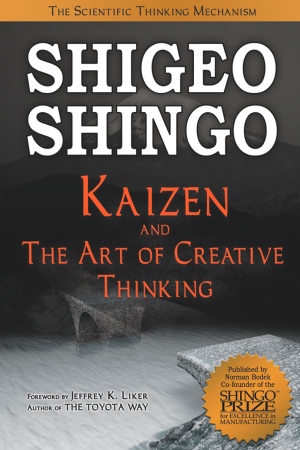
Deconstruct problems and rebuild them into improvement ideas
January 21, 2010
By Dr. Shigeo Shingo
 The following is an excerpt from a new book by Dr. Shigeo Shingo, the co-creator of the Toyota Production System, entitled Kaizen and the Art of Creative Thinking. Reproduced with permission from PCS Press.
The following is an excerpt from a new book by Dr. Shigeo Shingo, the co-creator of the Toyota Production System, entitled Kaizen and the Art of Creative Thinking. Reproduced with permission from PCS Press.
FINDING THE CAUSE:
IN PURSUIT OF PURPOSE
It is said that humans are the only animals that act based on reason. In fact, every action throughout our life has purpose; at least, that is how it should be. Due to the force of habit or sheer laziness, we often act without asking ourselves “why” or considering the true purpose of the action.
“Why do we eat?” If this question were asked, many would answer, “To gain nutrition, so that we can enjoy a long and healthy life.”
The reality may differ. Sometimes we eat just because food is there, or just to enjoy the momentary satisfaction of having food in our mouth. Even worse, we might eat a certain food because we saw it on a TV commercial, and are unwittingly serving the purpose of benefiting a company’s bottom line, instead of our long-term health.
For the most part, human action is based on reason.
Nevertheless, we often forget our purpose or misunderstand what the ultimate purpose really is. Consciously pursuing the purpose and reasoning behind one’s action is just as important in manufacturing as it is in our daily lives. Indeed, sometimes the solution to a problem is discovered only in the process of realigning our actions with their true purpose.
FOUR PURPOSES OF IMPROVEMENT
The purposes for factory improvement, for example, may include the following:
1. Increasing productivity
2. Improving quality
3. Cutting time
4. Cutting cost
The fulfillment of these purposes can act as a gauge for how well we are improving the factory. Conversely, failing to fulfill these purposes means there are problems that need to be fixed.
Thus, if we take the time to refine our actions on the basis of their intended purpose, problems will often disappear.
The success of this concept is contingent upon how well we identify and define our purpose. Think of the pursuit of purpose as a three dimensional concept where:
• X: represents the clear purpose of goals.
• Y: represents single or multiple purposes. If multiple, clarify each.
• Z: serves to fulfill the ideal to be reached, such as future state not-stock production.
SCRATCHING THE SURFACE
Knowing the job and knowing the purpose of the job are two very different things. We may know our job to the letter, but indifference or a lack of awareness as to why the job needs to be done can greatly limit our success.
TRUE PURPOSE OF INVESTIGATION
I was meeting with the president of N Mining Company in Kita-Kyushu when there was a knock on the door. It was Mr. Y, the mining director, and Mr. K, the accounting director. They had just returned from investigating the feasibility of acquiring a competitor’s mine that was (fiscally speaking) about to go under. I offered to leave while they gave their report, but the president insisted that I stay and listen.
“Things are in terrible shape, as we expected,” said Mr. Y.
“Their mining has been reckless and the roads and preparation facilities haven’t been maintained well at all.”
“Their accounting practices are just as bad,” chimed in Mr. K., the accounting director. “There are many outstanding ac- counts; payables that haven’t been paid off and receivables that haven’t been collected. It’s completely unorganized.”
Seemingly finished with their report, the president, who had been almost silent, opened his mouth. “Is that all?”
“Well . . . yes,” replied Mr. Y, reluctantly.
The president cocked an eyebrow at me, “As we all know, R Mining Company is on the verge of bankruptcy. Isn’t it expected that their operations would be in dire straits?
“I didn’t send you to confirm the obvious. I sent you to discover whether there’s still any potential left in the mine. Of course their operations are in shambles! But it’s possible there’s hope buried somewhere underneath, and I expected you to dig a little to find it!”
This episode taught me the importance of extending our thoughts beyond the job and onto the true purpose of our work, especially if it is not obvious from the given instructions. Confirming the development potential of the mine prior to acquisition was a crucial factor in the decision for N Mining to buy. Consequently, ascertaining this information was integral in the company’s investigational purpose. Although not specifically instructed to do so, had the two men considered this as their purpose upon their visit, perhaps they would have returned with information that could have served the growth of their company.
Advertisement
- X Tronics to distribute Elobau technologies
- Turning whiners into winners will help manufacturers compete globally